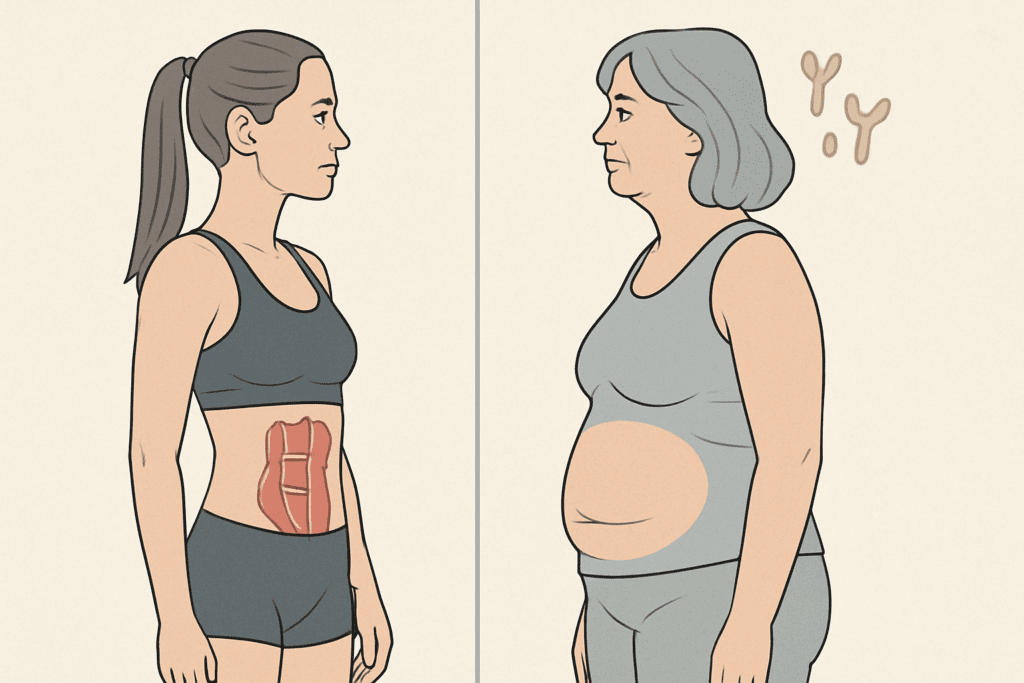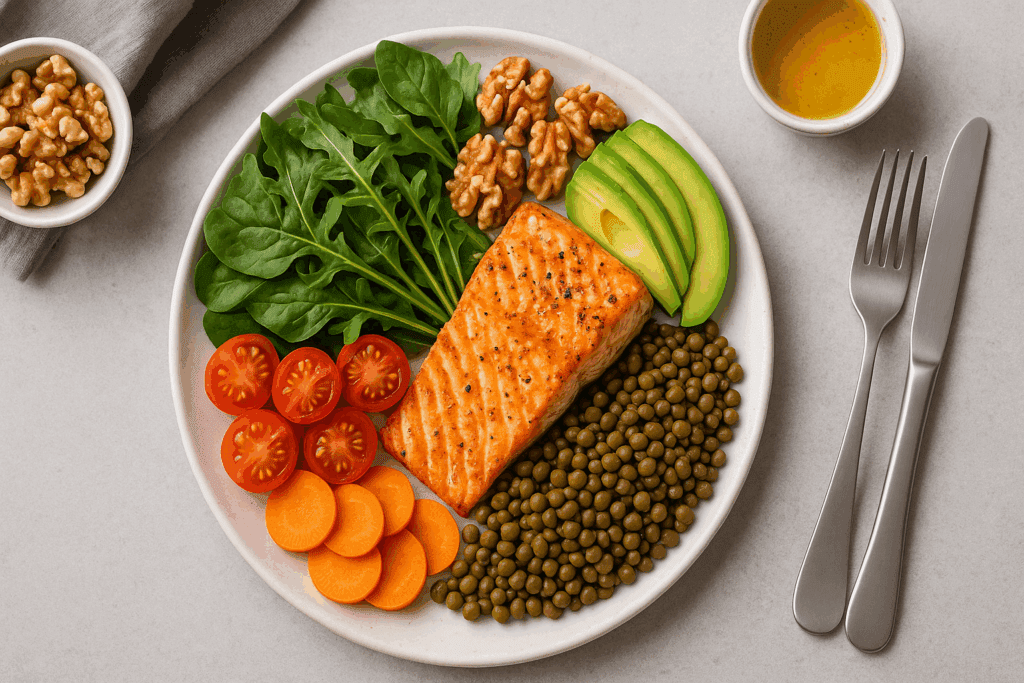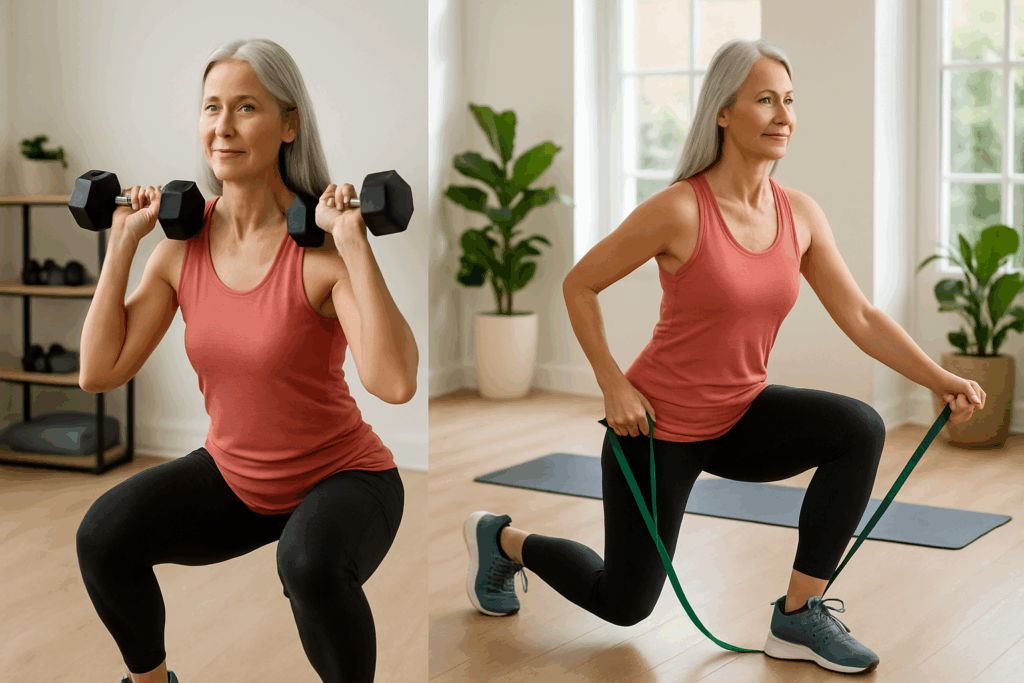Why Weight Loss After 40 Is Different for Women—and Why It Matters
Turning 40 often marks a meaningful shift in a woman’s relationship with her body. Metabolism slows. Hormones fluctuate. Fat distribution changes—often accumulating around the abdomen. These aren’t myths or exaggerations; they are real, physiologically driven shifts backed by science. While the principles of calorie balance and physical activity still apply, women over 45 face unique biological challenges that require targeted strategies for safe, sustainable fat loss. This makes finding a weight loss program for women over 45 not only essential but also fundamentally different from approaches designed for younger individuals.
You may also like: Expert-Backed Weight Loss Tips for a Healthier Lifestyle: What You Need to Know for Long-Term Weight Control and Wellness
Estrogen decline during perimenopause and menopause disrupts the body’s natural regulation of fat storage and muscle mass. Lean tissue diminishes while visceral fat increases, making it harder to maintain a healthy body composition. Additionally, insulin sensitivity tends to decrease, making it more difficult for the body to regulate blood sugar effectively. These internal changes mean that standard “eat less, move more” strategies, while not irrelevant, are often insufficient. Women over 40 need programs that address not just calories but hormones, inflammation, nutrient timing, and body composition goals. This is where a carefully designed plan specifically crafted for how to lose body fat in women over 40 becomes pivotal.

The Role of Hormones, Muscle Loss, and Metabolism in Midlife Fat Gain
Hormones govern nearly every process in the body—including fat storage, appetite regulation, and energy metabolism. As estrogen levels decline, there is a notable redistribution of fat from hips and thighs to the abdominal region. This is not only a cosmetic concern but also a serious health issue, as increased abdominal fat is associated with higher risks for heart disease, type 2 diabetes, and certain cancers.
Moreover, sarcopenia—the gradual loss of skeletal muscle mass that begins in your 30s and accelerates after 40—leads to a lower resting metabolic rate. Because muscle is more metabolically active than fat, less muscle means fewer calories burned at rest. Unfortunately, this decline often goes unnoticed until it begins to affect energy levels, strength, and body composition. It’s one of the many reasons why any effective weight loss program for women over 45 must include a strategy to preserve or rebuild lean muscle mass.
Cortisol, the body’s primary stress hormone, also tends to increase in midlife due to lifestyle pressures, poor sleep, or hormonal shifts. Chronic elevation in cortisol levels can further promote belly fat accumulation, making stress management another non-negotiable factor in any program aimed at sustainable fat loss.

How to Lose Body Fat for Women Over 40: Why Diet Quality Matters More Than Calories Alone
Calorie restriction is often the go-to method for weight loss, but for women over 40, what you eat matters just as much—if not more—than how much you eat. The body becomes more sensitive to the quality of nutrition, requiring higher amounts of protein, micronutrients, and fiber, even when calories are reduced. Diets high in processed carbohydrates and added sugars exacerbate insulin resistance, making it harder to burn stored fat.
Instead of focusing solely on cutting calories, a diet plan designed for how to lose body fat in women over 40 should prioritize nutrient density. That means plenty of leafy greens, lean protein sources like wild salmon or grass-fed poultry, omega-3-rich fats such as walnuts and flaxseeds, and slow-digesting carbohydrates from sources like quinoa or lentils. These foods help stabilize blood sugar, reduce inflammation, and support hormonal balance.
Protein becomes especially important, not only to support muscle maintenance but also to increase satiety and reduce cravings. Research shows that a higher-protein diet can improve body composition even in the absence of dramatic calorie restriction. Aim for at least 1.2 to 1.6 grams of protein per kilogram of body weight per day, spread evenly across meals. This supports metabolic function and helps preserve muscle mass—two critical objectives in any weight loss program for women over 45.

The Science of Macronutrient Timing and Meal Frequency for Midlife Fat Loss
While total calorie intake matters, emerging research suggests that when you eat may also influence fat loss, especially in midlife. Intermittent fasting protocols, such as time-restricted eating, have gained popularity for their ability to improve insulin sensitivity and reduce fat mass without muscle loss. However, not all intermittent fasting approaches are suitable for women over 45, particularly if hormonal health is already fragile.
A more balanced approach involves reducing evening eating, aligning meals with circadian rhythms, and ensuring the body gets enough nutrients during the day to support energy and hormonal stability. Breakfast should be protein-rich, as it sets the tone for satiety and blood sugar control throughout the day. Avoiding long stretches without food can help prevent cortisol spikes and reduce the risk of binge eating later in the evening.
Meal frequency doesn’t need to be rigid, but consistency is key. Most women over 40 do best with three well-balanced meals and one small snack. This prevents blood sugar crashes, supports thyroid function, and minimizes metabolic stress. As part of a well-structured strategy, this form of nutrient timing can significantly enhance the success of a weight loss program for women over 45.

Smart Exercise Strategies to Support Fat Loss After 40
Exercise plays a vital role in fat loss, but not all workouts are created equal—especially after 40. Long hours of cardio may lead to fatigue and muscle breakdown without significantly altering body composition. On the other hand, strength training is highly effective at increasing lean mass, supporting joint health, and boosting metabolism.
A weight loss program for women over 45 should prioritize resistance training at least three times a week. This can include bodyweight exercises, free weights, or resistance bands. Compound movements like squats, lunges, rows, and presses are especially effective because they work multiple muscle groups simultaneously and stimulate hormonal responses that encourage fat burning.
Low-impact cardio—such as brisk walking, swimming, or cycling—can still be a valuable part of the plan, particularly when done in moderate doses. It supports cardiovascular health and increases daily calorie expenditure. What matters most is sustainability. An exercise routine should be realistic, enjoyable, and suited to the individual’s fitness level and joint health.
Flexibility and mobility work, such as yoga or dynamic stretching, should also be included to reduce injury risk and enhance recovery. When paired with a properly calibrated diet, exercise becomes not just a calorie-burning tool but a metabolic enhancer, especially vital in the context of how to lose body fat for women over 40.

Sleep, Stress, and Inflammation: The Silent Saboteurs of Midlife Weight Loss
One of the most overlooked components of fat loss after 40 is the role of sleep and stress. Sleep disturbances become more common during perimenopause and menopause due to fluctuations in progesterone and estrogen. Poor sleep leads to higher ghrelin levels (the hunger hormone), lower leptin (the satiety hormone), and impaired glucose regulation—all of which contribute to fat gain, especially in the midsection.
Chronic stress, whether from work, caregiving responsibilities, or life transitions, keeps cortisol levels elevated. As mentioned earlier, this not only promotes fat storage but also breaks down muscle tissue, which in turn slows metabolism. Managing stress is therefore not a luxury but a cornerstone of any weight loss program for women over 45.
Techniques like mindfulness meditation, deep breathing, journaling, and gentle movement can lower cortisol levels and restore hormonal equilibrium. Sleep hygiene practices—such as keeping a consistent bedtime, avoiding screens before bed, and optimizing room temperature—are essential for restorative sleep. These non-diet, non-exercise interventions can be the difference between progress and plateau.
Medical Considerations: When to Seek Expert Help for Fat Loss Over 45
While many women can make significant progress with lifestyle changes, some may experience persistent difficulties despite their efforts. This is not a reflection of failure or lack of willpower—it may be a sign of underlying medical conditions. Thyroid disorders, insulin resistance, and perimenopausal hormonal imbalances can all interfere with fat loss and energy levels.
Getting a comprehensive medical evaluation is crucial if weight gain is sudden, unexplained, or accompanied by other symptoms like fatigue, depression, or menstrual irregularities. A functional medicine or integrative health provider can assess hormone levels, nutrient deficiencies, and metabolic health markers that conventional labs might overlook.
Bioidentical hormone replacement therapy, thyroid support, or targeted supplementation may be appropriate in certain cases. These should only be considered with the guidance of a healthcare provider who understands the complex interplay of hormones, metabolism, and aging. A doctor-supervised program ensures that women over 45 can pursue weight loss goals safely, effectively, and with long-term health in mind.
What to Look for in the Best Weight Loss Program for Women Over 45
Not all diet plans are designed with the physiology of women over 45 in mind. Many popular programs are either overly restrictive, too generalized, or based on outdated calorie-centric models. The best programs for this demographic should be rooted in medical science, personalized to the individual, and sustainable over the long term.
A truly effective weight loss program for women over 45 includes a whole-foods, anti-inflammatory diet that supports hormonal balance. It offers a realistic exercise plan that emphasizes resistance training and mobility. It addresses sleep, stress, and mindset as equally important pillars of success. Most importantly, it evolves with the woman’s changing needs rather than imposing rigid standards that ignore age-specific challenges.
Many health experts now recommend a hybrid model that combines structured guidance—through meal plans or coaching—with the flexibility to adapt to each woman’s lifestyle, preferences, and metabolic needs. Programs that offer educational resources, accountability check-ins, and health tracking tools are particularly beneficial. They reinforce behavior change while empowering women to take charge of their health in a sustainable, informed way.

The Psychology of Midlife Weight Loss: Mindset, Motivation, and Self-Compassion
One of the most underestimated aspects of how to lose body fat in women over 40 is the psychological element. Years of dieting, societal pressure, and changing body image can create emotional fatigue. Many women feel discouraged before they even begin, fearing failure or recalling past programs that didn’t work.
Addressing mindset is essential. Weight loss at this stage of life is not just about fitting into smaller jeans—it’s about regaining vitality, confidence, and control. Self-compassion, rather than self-criticism, has been shown to improve motivation, reduce emotional eating, and lead to more lasting results. Understanding that setbacks are part of the process—not signs of failure—is critical.
Goal setting should shift from short-term weight goals to broader wellness markers: strength, energy, quality of sleep, mood stability, and confidence. When women approach fat loss from a place of self-care rather than punishment, they are more likely to adopt behaviors that nourish their bodies instead of depriving them. The emotional landscape of midlife is complex, and the most successful programs acknowledge and support the whole person—not just the number on the scale.
Embracing the Journey: A New Definition of Success After 40
There’s a profound freedom in realizing that weight loss after 45 is not about chasing an unrealistic ideal, but about optimizing your body’s function for the next chapter of life. It’s about aging with strength, grace, and vitality—not fighting biology, but working with it.
Sustainable fat loss at this stage involves far more than just eating less and exercising more. It’s a holistic recalibration of nutrition, hormones, metabolism, mindset, and lifestyle. For many women, this becomes a transformative experience—one that redefines their relationship with their bodies, their health, and their self-worth.
By choosing a weight loss program for women over 45 that is rooted in medical science, built around realistic goals, and aligned with your body’s evolving needs, you are making an investment not just in aesthetics but in lifelong wellness. It is not too late. In fact, in many ways, this is the perfect time.
Frequently Asked Questions: Best Weight Loss Program for Women Over 45 and How to Lose Body Fat After 40 Safely
1. Why do many traditional weight loss plans fail women over 45, even when they’re following them closely?
Many mainstream diets are designed around younger bodies with more robust hormonal balance and faster metabolic rates. Women over 45 experience physiological changes such as decreased estrogen, slower thyroid activity, and reduced insulin sensitivity, which affect fat storage and energy use. This makes conventional calorie-cutting approaches less effective and often counterproductive, especially when they don’t consider muscle preservation, hormonal fluctuations, or stress load. A targeted weight loss program for women over 45 must account for these changes through personalized strategies that emphasize hormonal support, nutrient timing, and metabolic flexibility. That’s why understanding how to lose body fat in women over 40 with a diet plan tailored to midlife biology is essential for real and sustainable results.
2. Can intermittent fasting be part of an effective fat-loss strategy for women over 45?
Intermittent fasting can be helpful for some women over 45, especially when it improves insulin sensitivity and reduces late-night snacking. However, strict fasting windows may backfire if hormonal health is already compromised, especially in women dealing with adrenal fatigue or sleep issues. The key is to choose an approach that aligns with the body’s stress response and provides enough nutrients during eating windows to prevent muscle loss. For many, a gentler version of time-restricted eating—such as a 12:12 schedule—is more sustainable and hormonally appropriate. Including intermittent fasting as part of a customized weight loss program for women over 45 can enhance results, but it should be implemented with medical insight and flexibility.
3. How can women over 45 maintain muscle mass while still losing body fat?
Preserving muscle while losing fat is a nuanced process that goes beyond simply increasing protein. Resistance training is non-negotiable—it should include progressive overload to stimulate muscle retention and growth. Additionally, spacing protein intake evenly throughout the day and consuming 25–30 grams per meal supports muscle protein synthesis. Some research also supports the inclusion of leucine-rich foods like eggs, fish, and whey protein, which trigger anabolic responses beneficial for women in midlife. When crafting a diet plan for how to lose body fat in women over 40, it’s essential to integrate both strength training and optimal protein timing to counteract age-related muscle loss and improve metabolic outcomes.
4. Are there any overlooked nutrients that can support fat loss in women over 45?
Yes, and magnesium is one of the most commonly deficient yet critical nutrients. It supports hundreds of enzymatic processes, including those involved in glucose regulation and cortisol modulation. Vitamin D, omega-3 fatty acids, and B-complex vitamins also play important roles in managing inflammation, mood, and energy—all factors that influence fat metabolism and adherence to a weight loss program for women over 45. Some emerging evidence even suggests that sufficient calcium and vitamin K2 intake may influence how fat is stored around the midsection in postmenopausal women. Addressing these micronutrient gaps can significantly improve the effectiveness of a long-term fat-loss strategy tailored for this age group.
5. How important is gut health when following a weight loss program for women over 45?
The gut microbiome becomes increasingly influential as we age, with emerging research linking gut diversity to lower body fat percentages and improved metabolic flexibility. Women over 45 often experience digestive changes due to decreased estrogen and stomach acid, which can alter microbiota composition. Probiotic-rich foods like kefir, sauerkraut, and miso—as well as prebiotic fibers found in asparagus, onions, and oats—can enhance microbial diversity. A gut-friendly diet plan for how to lose body fat in women over 40 should also limit processed foods and excess sugar, both of which disrupt microbial balance. Supporting gut health can improve nutrient absorption, reduce inflammation, and stabilize appetite—essential elements for sustained fat loss.
6. Can menopause hormone therapy (MHT) play a role in weight loss for women over 45?
Menopause hormone therapy, when medically appropriate, may help some women reduce central fat accumulation and improve body composition. Estrogen has a known regulatory role in fat distribution, and restoring optimal levels may mitigate the shift toward abdominal adiposity. MHT is not a weight loss drug, but it can be a supportive element when integrated with a comprehensive weight loss program for women over 45. Candidates for hormone therapy should undergo thorough evaluation, including personal and family medical history, cardiovascular risk, and bone health status. For some, MHT can provide the metabolic stability needed to respond more effectively to diet and exercise efforts tailored to midlife fat loss.
7. How can mindset and emotional wellness impact fat loss results after 40?
Psychological resilience becomes increasingly important for midlife women attempting to lose body fat. Many struggle with long-held beliefs about weight, body image, and food morality. These internal narratives can sabotage progress through cycles of guilt, restriction, and emotional eating. Cognitive-behavioral tools, mindfulness-based eating, and journaling practices can help uncover and reshape these patterns. Incorporating mindset work into a how to lose body fat women over 40 diet plan can dramatically improve adherence, reduce stress-related eating, and enhance self-trust—qualities that are often more decisive than the specific macronutrient breakdown.
8. Is cardio still necessary in a weight loss program for women over 45, or can strength training alone suffice?
While strength training is foundational, moderate cardio still has a place in supporting cardiovascular health, insulin sensitivity, and calorie expenditure. The key is to avoid excessive cardio, which may lead to muscle loss and elevated cortisol, especially in women already managing stress or sleep disturbances. A balanced weekly routine might include 2–3 strength training sessions complemented by 2–3 brisk walks, dance classes, or swimming sessions. For women over 45, consistency and recovery are more important than intensity. Including a strategic mix of movement modalities in a weight loss program for women over 45 not only protects lean mass but also supports metabolic health and emotional wellbeing.
9. How long does it typically take to see results from a diet plan tailored to women over 40?
Fat loss after 40 tends to progress more slowly, and this is not a sign of failure—it’s a reflection of how metabolism adapts over time. Visible changes may take 6–12 weeks depending on starting body composition, hormonal status, and adherence to both diet and lifestyle interventions. A high-quality how to lose body fat women over 40 diet plan will emphasize steady, sustainable progress rather than rapid transformation. Non-scale victories—like improved sleep, reduced cravings, and better energy—often show up first and serve as early indicators of success. It’s critical for women in this age group to recalibrate expectations and define success through holistic health improvements, not just pounds lost.
10. What future trends or innovations may improve fat loss outcomes for midlife women? Personalized nutrition based on genetic testing, microbiome mapping, and metabolic typing is gaining traction and may eventually allow for hyper-customized diet plans that cater to individual biology. Continuous glucose monitors (CGMs) are another emerging tool, offering real-time insights into how specific foods impact blood sugar, which is particularly useful in crafting a tailored how to lose body fat women over 40 diet plan. Artificial intelligence is also being used to analyze sleep, stress, and hormonal biomarkers, helping women adapt their fat-loss strategies more dynamically. Additionally, research on adaptogenic herbs and peptides may unlock new avenues for supporting metabolism and hormone balance naturally. These advancements suggest that future weight loss programs for women over 45 will be increasingly personalized, data-driven, and rooted in integrative health.
Final Thoughts: Finding the Best Weight Loss Program for Women Over 45 That Supports Body Fat Loss After 40 Safely
When it comes to choosing the best weight loss program for women over 45, the key is to align science with self-care. An effective plan doesn’t just tell you what to eat—it helps you understand why certain foods nourish your changing metabolism. It doesn’t just prescribe exercise—it shows you how movement can support your hormone health and energy. And it doesn’t just focus on losing weight—it helps you build a sustainable lifestyle that supports your body’s ability to thrive well beyond your 40s.
The most successful diet plan for how to lose body fat in women over 40 is the one that adapts with you, not against you. It prioritizes lean protein, whole foods, and nutrient-rich meals. It incorporates resistance training and restorative movement. It supports quality sleep, stress reduction, and a positive mindset. And most importantly, it respects your individuality—because no one-size-fits-all solution can capture the complexity and beauty of the female body in midlife.
If you’re navigating this transition, know that you’re not alone—and you don’t need to resort to extreme diets or punishing workouts. By following a doctor-recommended, research-backed strategy, you can achieve meaningful fat loss while gaining strength, energy, and renewed confidence. Let this be the beginning of a healthier, empowered future.
Was this article helpful? Don’t let it stop with you. Share it right now with someone who needs to see it—whether it’s a friend, a colleague, or your whole network. And if staying ahead on this topic matters to you, subscribe to this publication for the most up-to-date information. You’ll get the latest insights delivered straight to you—no searching, no missing out.
Further Reading:
10 Tips On Following The Best Diet For Women Over 40
13 Best Ways to Lose Weight After 40, According to Experts
The 3 Best Diets for Women Over 50, According to Doctors and Dietitians


